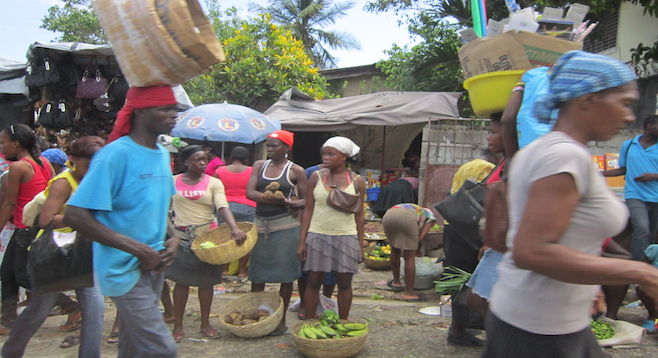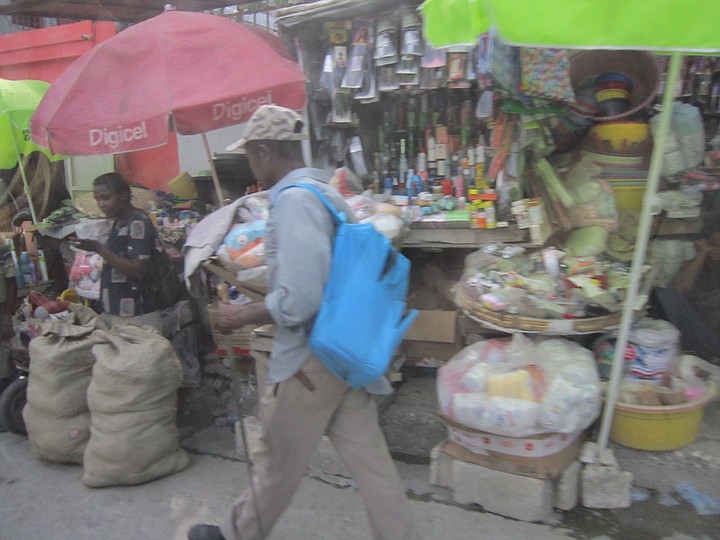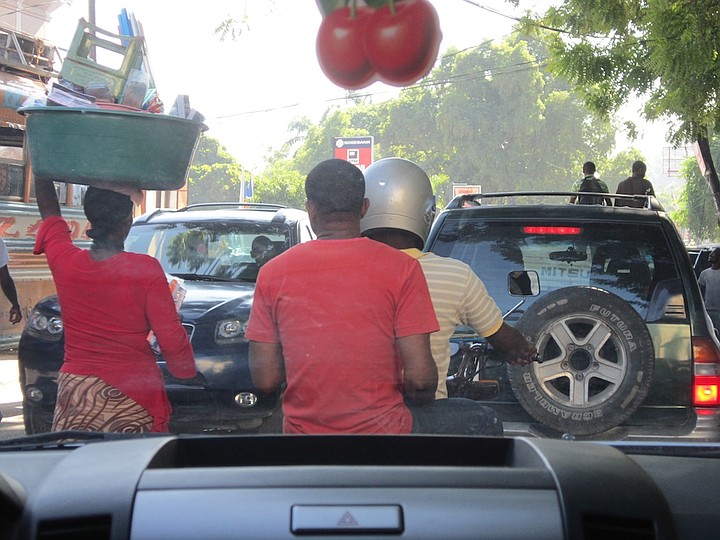 Facebook
Facebook
 X
X
 Instagram
Instagram
 TikTok
TikTok
 Youtube
Youtube

I stepped off the plane and onto the tarmac, directed toward a small white building with bright blue lettering: "Toussaint Louverture."
The massive cracks in the side of the building were visible even before we touched down. I followed the crowd – Haitians returning home, visiting relatives, modestly clad missionaries, church groups with several duffel bags per person – until we started down a single escalator, bound for security checks and baggage claim.
I could hear music that reminded me of New Orleans, bass drums and brass instruments, and as we got closer, I was surprised to see a small band positioned at the bottom of the escalator, each member wearing a red t-shirt with the logo of the local phone company prominently printed in white across the front.
I travel light, usually with only a backpack and a laptop bag, even for international trips, so I was able to skip over the baggage claim area, which was nothing more than piles of bags about a 20x20 floor. After declaring only myself and my media equipment, I found my way outside. I was thrust into a huge crowd of people, all men, and all extremely interested in carrying my bags to their car. My friends were waiting for me, but finding the two sisters in this sea of eager-to-be-paid drivers took a little longer than anticipated.
The girls found me. I ran over and excitedly embraced them – two young sisters from Pittsburgh who've been living and working in the capital, Port-au-Prince, since just out of high school – and we headed toward their home, or rather: home base, workspace, supply storage, where the day-to-day operations of their nonprofit are situated. Most of their time is spent in the field, visiting families enrolled in one or more of their programs. I learned all this on the 90-minute drive from the airport.
They spend a majority of their work hours in a truck, driving over rough terrain to appointments sometimes hours away from Port-au-Prince. Going to their home first would help me ground myself for a week in the homes of some of Haiti's most needy.
The sisters provide social services that aren't part of a sorely lacking governmental infrastructure in Haiti – support that would help a struggling family with immediate financial or food-based needs – services like those found in the United States. I'd traveled to Haiti to learn more about their programs.

We traveled along bumpy unpaved roads lined with litter and the occasional farm animal tied to feed off what grass grows nearby. We drove through the center of a few villages. Each side of the narrow street was lined with umbrella carts (for those who can afford one) or simple stands full of items such as clothing, fruit, school supplies, live chickens, mattress, repurposed goods and art (left). Most people who sell goods at the main street markets like this one travel a great distance to sell items to support their family, and often times do so by foot or by hitching a ride. These stands sell a lot of goods – but that doesn't equate to a lot of money.
On this sunny weekday just after lunch, each village market is packed. The late summer temperature hovers above 90 and there's little breeze. But I don't see sweat. I see smiles.

The main roads are filled with Haitians – on foot, mopeds, even bicycles, although I'm not sure how a bicycle tire can survive on these rocky roads. I compare this terrain to that of the Trans-Labrador Highway in northeastern Canada, the primary road in an extremely remote portion of that country.
Competing with the traffic of cars, trucks and tap taps - usually overweight and overpacked taxis that riders tap the top of when ready to exit - I can't fathom how movement works so well here. But the flow is constant. Almost effortless. Traffic, people, animals are all moving together, all the time. There is no stopping in Haiti.


I stepped off the plane and onto the tarmac, directed toward a small white building with bright blue lettering: "Toussaint Louverture."
The massive cracks in the side of the building were visible even before we touched down. I followed the crowd – Haitians returning home, visiting relatives, modestly clad missionaries, church groups with several duffel bags per person – until we started down a single escalator, bound for security checks and baggage claim.
I could hear music that reminded me of New Orleans, bass drums and brass instruments, and as we got closer, I was surprised to see a small band positioned at the bottom of the escalator, each member wearing a red t-shirt with the logo of the local phone company prominently printed in white across the front.
I travel light, usually with only a backpack and a laptop bag, even for international trips, so I was able to skip over the baggage claim area, which was nothing more than piles of bags about a 20x20 floor. After declaring only myself and my media equipment, I found my way outside. I was thrust into a huge crowd of people, all men, and all extremely interested in carrying my bags to their car. My friends were waiting for me, but finding the two sisters in this sea of eager-to-be-paid drivers took a little longer than anticipated.
The girls found me. I ran over and excitedly embraced them – two young sisters from Pittsburgh who've been living and working in the capital, Port-au-Prince, since just out of high school – and we headed toward their home, or rather: home base, workspace, supply storage, where the day-to-day operations of their nonprofit are situated. Most of their time is spent in the field, visiting families enrolled in one or more of their programs. I learned all this on the 90-minute drive from the airport.
They spend a majority of their work hours in a truck, driving over rough terrain to appointments sometimes hours away from Port-au-Prince. Going to their home first would help me ground myself for a week in the homes of some of Haiti's most needy.
The sisters provide social services that aren't part of a sorely lacking governmental infrastructure in Haiti – support that would help a struggling family with immediate financial or food-based needs – services like those found in the United States. I'd traveled to Haiti to learn more about their programs.

We traveled along bumpy unpaved roads lined with litter and the occasional farm animal tied to feed off what grass grows nearby. We drove through the center of a few villages. Each side of the narrow street was lined with umbrella carts (for those who can afford one) or simple stands full of items such as clothing, fruit, school supplies, live chickens, mattress, repurposed goods and art (left). Most people who sell goods at the main street markets like this one travel a great distance to sell items to support their family, and often times do so by foot or by hitching a ride. These stands sell a lot of goods – but that doesn't equate to a lot of money.
On this sunny weekday just after lunch, each village market is packed. The late summer temperature hovers above 90 and there's little breeze. But I don't see sweat. I see smiles.

The main roads are filled with Haitians – on foot, mopeds, even bicycles, although I'm not sure how a bicycle tire can survive on these rocky roads. I compare this terrain to that of the Trans-Labrador Highway in northeastern Canada, the primary road in an extremely remote portion of that country.
Competing with the traffic of cars, trucks and tap taps - usually overweight and overpacked taxis that riders tap the top of when ready to exit - I can't fathom how movement works so well here. But the flow is constant. Almost effortless. Traffic, people, animals are all moving together, all the time. There is no stopping in Haiti.
Comments